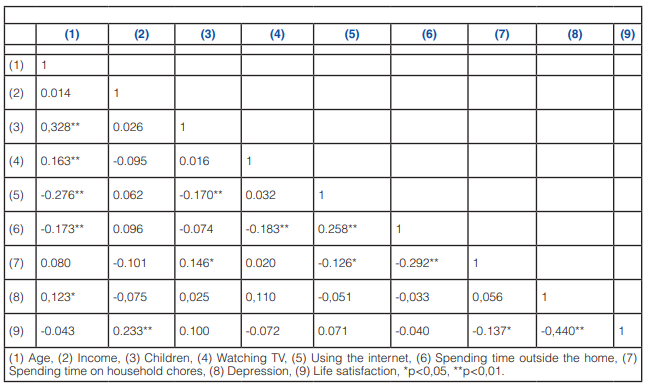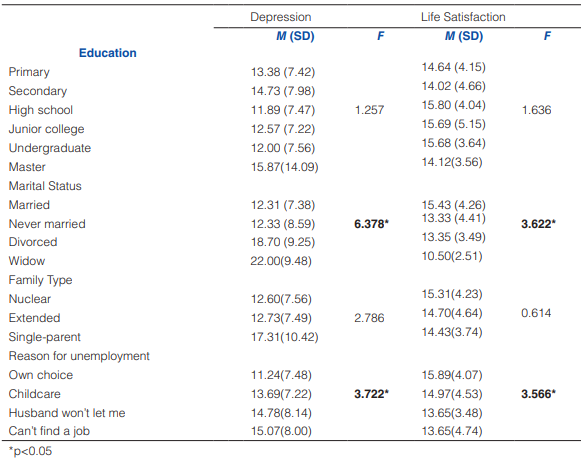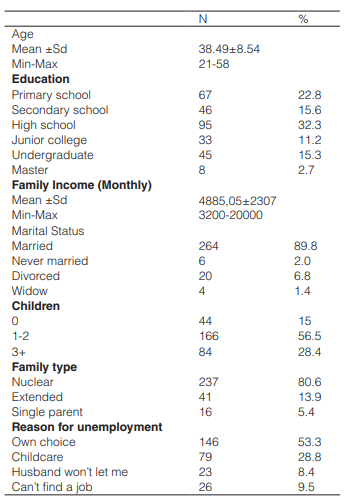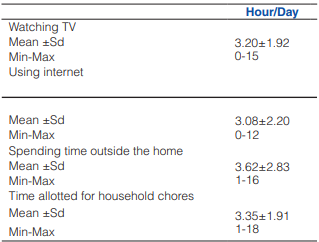Introduction
As with the concept of woman, there are different perspectives and definitions for the concept of the housewife. Some groups define housewives with their traditional roles, some deal with modern features, and some do not even accept the concept (Beijing Declaration and Platform for Action, 2012). Based on the common definitions, housewives are stated as “people who have full-time responsibilities for housework and child care” (Kitterød & Rønsen, 2011). The contribution of men and women to the total family income, known as double or double-earner, can occur as a result of social and economic needs in the modern sense (Shehan, et al., 1986). This situation increases the ongoing discussions about housewives from the past to the present and may reveal the necessity of re-understanding the social roles of women. There are still widespread stereotypes about women's participation in business life (Mueller & Datoon, 2008). On the other hand, women's participation in business life has increased and their career ideas have improved compared to the past. Thus, the traditional roles of women can become more flexible (Dibaji, et al., 2017).
Considering this development process in the context of social work; It is stated that theories, approaches and practices specific to the social work discipline are also effective (Johnson & Lloyd, 2004). Another important point in this direction is the beliefs and awareness levels of women regarding their rights and freedoms (Dominelli, 2002). The work of social work towards the individual, family and society can enable a radical change in the problem of women and aims to eliminate women's problems.
Studies on the relationship between women's participation in business life, depression and life satisfaction have increased in recent years (Mavric, et al., 2016). These studies reveal the differences between working and non-working women. When the literature is examined, the studies on the problems of working women and related depression or life satisfaction are relatively sufficient, but the studies examining the life satisfaction and depression of women who have full-time household responsibilities are quite limited. It is thought that this study will contribute to the limited number of studies dealing with depression and the life satisfaction of housewives.
Depression and Life Satisfaction in Housewives
Depression is seen as a key factor that causes many diseases and its effects can last for many years. Studies showing that depression is related to socio-economic factors reveal that there is a significant relationship between individuals' income and depression levels (Raza, et al., 2017). There is no clear definition of life satisfaction that is agreed upon and accepted by everyone (Prasoon & Chaturvedi, 2016). However, it is seen that happiness and well-being come to the fore in the evaluations regarding the concept (Feldman, 2008). Factors such as age, education, business life, family and social life affect the life satisfaction of individuals (DeFour & Brown, 2006).
Even if women work in certain jobs outside the home, they may have to carry out roles such as home responsibility and child care. This situation can increase the psychological pressure on housewives. In addition to financial factors, it is stated that the inability of housewives to adequately participate in social support systems resulting from home and child care periods is also effective (Dibaji, et al., 2017). Contrary to the thought that women should have their own goals and expectations, the places and times where women want to experience satisfaction can be created by others. Wide acceptance of stereotypes such as “a woman should be at home” can push women away from the threshold of life satisfaction (Kedar & Gopinathan, 2016).
Materials and methods
In this study, descriptive and relational models were used. In the study, the socio-demographic characteristics of the participants were examined descriptively. Relationally, the relationship between socio-demographic characteristics of housewives and depression and life satisfaction was investigated.
The universe of the research consists of housewives living in Istanbul, Turkey. However, there is no definite data on the number of housewives in Istanbul. For this reason, the convenient sampling method, which is among the non-probability sampling methods, was used in the study. The sample of the study consists of 739 housewives. Participants were informed about the research by phone. Questionnaires were sent to the housewives who volunteered to participate in the research via e-mail. The responses received from 294 housewives were analyzed.
Data Collection Tools
In this section, information will be given about the ‘Socio-Demographic Form’, ‘Depression Scale’ and ‘Life Satisfaction Scale’.
Socio-Demographic Form
The semi-structured questionnaire prepared by the researcher consists of 15 questions. It includes questions about the socio-demographic characteristics and daily routines of housewives.
Beck- Depression Scale
The Beck-Depression scale was developed by Beck, et al. (1961), and consists of 21 items. The questions are answered using a four-point Likert scale. Each response is scored between zero and three, and the total score of the scale ranges from 0 to 63. The scale's adaptation to Turkish, validity and reliability studies were carried out by Hisli (1989). The reliability coefficients of the scale (halving reliability r=.74, Cronbach alpha r=.80) and validity coefficient (r=.63) were found to be an appropriate measurement tool (Hisli, 1989).
Life Satisfaction Scale
The Life Satisfaction Scale was developed by Diener (1985), and consists of five items. The questions are on a seven-point Likert scale are answered. Scores from each item were one to seven; the total score varies between five and thirty-five. As the score increases, the level of life satisfaction also increases. The Turkish adaptation of the scale was carried out by Köker (1991), and the test-retest reliability coefficient was found to be α= .85. Validity and reliability studies reveal that the scale is a suitable measurement tool for the assessment of life satisfaction.
Statistical Analysis
Data analysis was done with SPSS 25.0 program. Descriptive analyzes of all variables were performed. Pearson correlation analysis and one-way analysis of variance (ANOVA) were used to reveal the relationship between socio-demographic information, depression and life satisfaction. In addition, multivariate regression analysis and hierarchical regression analysis were performed to reveal the extent to which socio-demographic information and depression mediators affect the level of significance between life satisfaction.
Results and discussion
Table 1 includes the socio-demographic information of the participants. All of the participants were women and their ages ranged from 21 to 58. The mean age of the participants was 38.49±8.54 (mean±sd) and 32.3% of them were high school graduates. The average monthly household income was found to be 4885 TL and 89% of them were married. 80.6% of the participants live in a nuclear family and 37.1% are mothers of two children.
In Table-2, the average TV watching time of the participants is 3.2 (hours/day); internet usage is approx 3 (hours/day); spending time outside the home 3.62 (hours/day); spending time for housework was found to be 3.35 (hours/day).
As seen in Table 3, there is a negative significant relationship between depression and life satisfaction (r= -0.440; p< 0.01). There was a positive significant correlation between age and depression (r= 0.123; p< 0.05); income and life satisfaction (r= 0.233; p< 0.01); age and number of children (r= 0.328; p< 0.01); age and TV viewing time (r= 0.163; p< 0.01); number of children and spending time for housework (r= 0.146; p< 0.05). There was negative significant correlation between time spent on housework and life satisfaction (r=- 0.137; p< 0.05); age and internet use (r= -0.276; p< 0.01); age and time spent outside the home (r= -0.173; p< 0.01). There is a negative significant relationship between the number of children and internet use (r= -0.170; p< 0.01); watching TV and time spent outside the home (r=-0.258; p< 0.01); internet use and spending time for housework (r= -0.126; p< 0.05); spending time for housework and spending time outside the home (r= -0.292; p< 0.01).
Table 3 - Correlation Coefficients: Depression, Life Satisfaction, Socio-Demographic Information and Daily Routine Variables.

As seen in Table-4, a significant relationship was found between marital status, depression and life satisfaction (p< 0.05). Depression level was found to be significantly lower in married participants. In addition, the level of life satisfaction in married participants was found to be significantly higher. A significant correlation was found between depression and life satisfaction levels due to not working (p< 0.05). The depression levels of the participants who stated that they did not work because their husband did not allow them, and those who stated that they did not work because they could not find a job; life satisfaction levels were found to be significantly lower. There was no significant relationship between education level, depression and life satisfaction (p>0.05). Likewise, no significant relationship was found between family type, depression and life satisfaction (p>0.05). Although there was no significant relationship, the average depression level of the participants with a nuclear family was lower, and the average life satisfaction was higher.
Table 4 - Means, Standard Deviations, and One-Way Analysis of Variance (ANOVA): Depression, Life Satisfaction, and Socio-Demographic Information.

In Table-5, socio-demographic information in Step-1 explains 11% of housewives' life satisfaction (R=0.33, R2 =0.11, F=3.62, p<0.01). With the inclusion of depression in the regression analysis in Step-2, 30% of the total variance is explained (R=0.55, R2 =0.30, F=10.77, p<0.01).
Table 5 - Hierarchical multiple regression analysis of the relationship between depression and socio-demographic information in the evaluation of housewives' life satisfaction.

This study aims to reveal the relationship between socio-demographic characteristics, depression and life satisfaction levels of housewives in Istanbul, Turkey. Although many studies in the literature compare working and non-working women, studies that directly address depression and the life satisfaction of housewives are very limited. In line with the findings of this study, Mavric, et al. (2016), found a negative significant relationship between depression and life satisfaction levels of housewives. Similarly, Lewis, et al. (1999), found a negative significant relationship between depression and life satisfaction levels of housewives. In the same study, a positive relationship was found between income and life satisfaction in parallel with this research.
In the study of Sundriyal & Kumar (2013), in which the effect of marital status on life satisfaction and depression level was examined, the depression levels of the unmarried participants were found to be significantly higher, in line with the findings of this study. In addition, in the same study, the life satisfaction of married participants was found to be significantly higher.
Study conducted by Stehan et al. (1986) on how the age of housewives affects the level of depression, a positive significant relationship was found between the age of housewives and their depression levels. Similarly, in this study, a significant relationship was found between the age of housewives and their depression levels. Lu (1994), did not find a significant relationship between total family income and life satisfaction. However, in this study, a positive significant relationship was found between life satisfaction and total family income.
In this study, approximately one out of every two housewives states that not working is their choice. In another study, it is stated that the preference of housewives to be a housewife instead of business life has increased in recent years. Behind the choice of being a housewife is the acceptance of the idea that the housework is suitable for her personality, the high cost of childcare, the desire to spend more time with the child, the desire to live in a tidy house, and the idea that the man should earn money and the woman should take care of the housework. Social work research is needed to reveal the reasons behind this preference.
Study has shown that household income, housework responsibilities, time devoted to relatives, and child care are associated with depression (Shehan, et al., 1986). In this study, there was no significant relationship between household income, time devoted to housework, and the number of children and depression. In this study, a significant positive relationship was found between income and life satisfaction, and a negative significant relationship was found between the time devoted to housework and life satisfaction.
Conclusions
There was a positive relationship between age and depression; income and life satisfaction. There was a negative relationship between time spent on housework and life satisfaction. Depression level was found to be significantly lower in married participants. In addition, the level of life satisfaction was found to be significantly higher in married participants. The depression levels of the participants who stated that they did not work because their partners did not allow them, and those who could not find a job, were significantly higher than the other participants; life satisfaction levels were found to be significantly lower. There was no significant relationship between education level, depression and life satisfaction. Likewise, no significant relationship was found between family type, depression and life satisfaction. A negative significant relationship was found between depression and life satisfaction of housewives. Among the main objectives of the social work discipline is the client's control over his own life. There is a need to carry out studies at micro, mezzo and macro levels to empower women who are separated from working life due to their own will. It is necessary to provide training on gender equality to men, and to raise awareness in the public with the support of the media in this area. It is thought that the findings of this research will contribute to the determination of the problem, which is among the steps of working with society. More social work research should be conducted and supported, focusing on housewives and especially men who prevent their spouses from participating in business life.
















